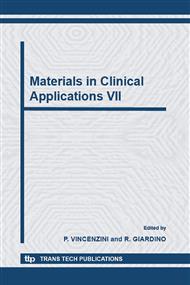[1]
L. L. Hench, Biomaterials: a forecast for the future, Biomaterials, 19 (1998) 1419-1423.
DOI: 10.1016/s0142-9612(98)00133-1
Google Scholar
[2]
M. L. Roemhildt, T. D. McGee, S. D. Wagner, Novel calcium phosphate composite bone cement : strength and bonding properties, Journal of Materials Science : Materials in Medicine, 14 (2003) 137-141.
Google Scholar
[3]
M. Nilsson, Injectable calcium sulphate and calcium phosphate bone substitutes, Ph. D Thesis, Lund (2003).
Google Scholar
[4]
A. Faris, H. Engqvist, J. Lööf, M. Ottosson, L. Hermansson, In vitro bioactivity of injectable ceramic orthopaedic cements, presented at Bioceramics 18, Kyoto 2005, to be published.
Google Scholar
[5]
N. Axen, H Engqvist, J Loof, P Thomsen and L Hermansson, In vivo hydrating Calcium aluminate coatings for anchoring of metal implants in Bone, Key Eng Mater. 284-286 831-834.
DOI: 10.4028/www.scientific.net/kem.284-286.831
Google Scholar
[6]
L . Kraft, Calcium Aluminate Based Cement as Dental Restorative Materials, Ph D Thesis, Faculty of Science and Technology, Uppsala University, Sweden. (2002).
Google Scholar
[7]
N. Axen, T. Persson, K. Björklund, H. Engqvist, L. Hermansson. An Injectable Bone Void Filler Cement based on Ca-Aluminate . Key Eng Mater 254-256 (2004) pp.265-268.
DOI: 10.4028/www.scientific.net/kem.254-256.265
Google Scholar
[8]
Patterson R J, Mayer D, Weaver L, Phaneuf M W. H-Bar Lift-Out" and "Plan-View Lift-Out,: Robust, Re-thinnable FIB- TEM preparation for ex-situ cross-sectional and plan-view FIB specimen preparation. Submitted to Microscopy and Microanalysis.
DOI: 10.1017/s1431927602105502
Google Scholar
[9]
H. Engqvist, J-E. Schultz-Walz, J. Loof, G. A. Botton, D. Maye , M. W. Pfaneuf, N-O. Ahnfelt , L. Hermansson Chemical and Biological Integration of a Mouldable Bioactive Ceramic Material capable of forming Apatite in vivo in Teeth,. Biomaterials 25 (2004).
DOI: 10.1016/j.biomaterials.2003.09.053
Google Scholar
[10]
T.C. Power and T.L. Brownyard, Studies of the physical properties of hardened Portland cement pastes, J American Concrete Institute Proc 43, 492-498 (1946).
Google Scholar
[11]
J. Lööf, H. Engqvist, G. Gómez-Ortega, H. Spengler, N-O Ahnfelt and L. Hermansson, Mechanical Property Aspects of a Biomineral Based Dental Restorative System, Key Eng Mater 284-286 , 741-7444 (2005).
DOI: 10.4028/www.scientific.net/kem.284-286.741
Google Scholar
[12]
J Lööf, H. Engqvist, L. Hermansson and N-O Ahnfelt, Mechanical Testing of Chemically Bonded Bioactive Ceramic Materials, Key Eng. Materials Vols. 254-256 51-54 (2004).
DOI: 10.4028/www.scientific.net/kem.254-256.51
Google Scholar
[13]
H. Engqvist, E. Abrahamsson, J. Lööf and L. Hermansson , Microleakage of a Dental Restorative Material based on Biominerals, Proc. 29th Inter. Cocoa Beach Conf. on Advanced Ceramics & Composites, Jan (2005).
Google Scholar


